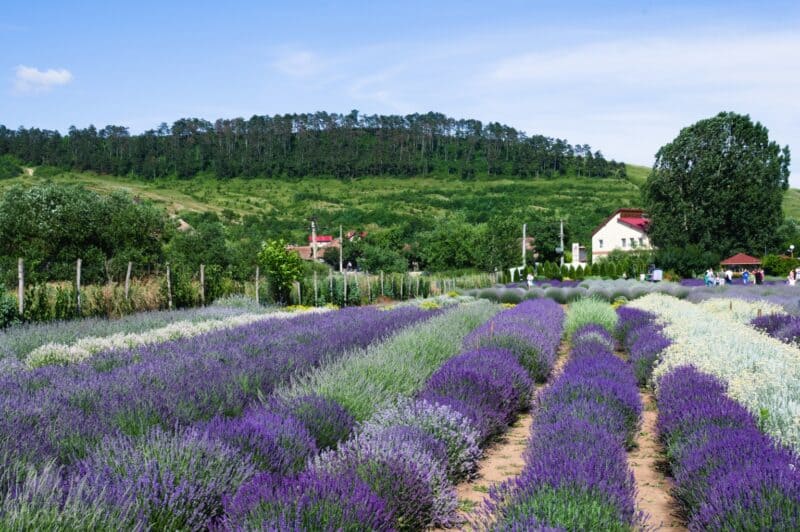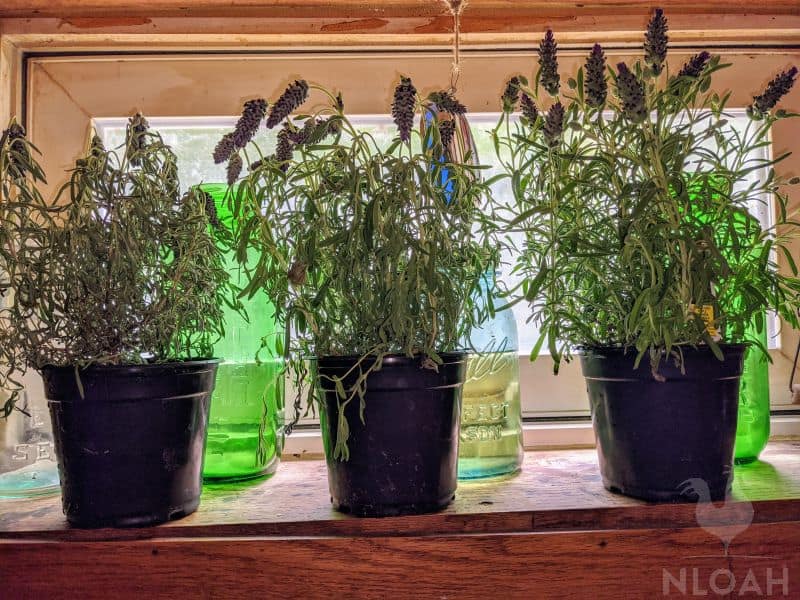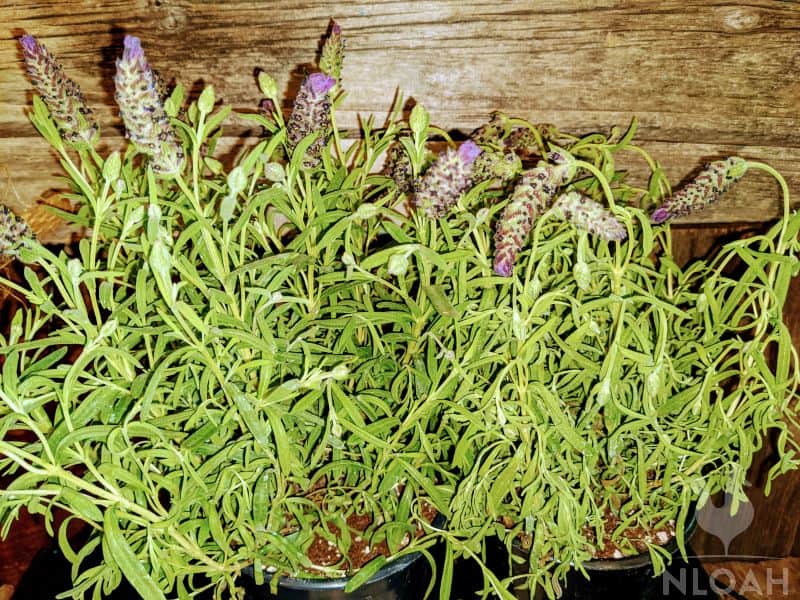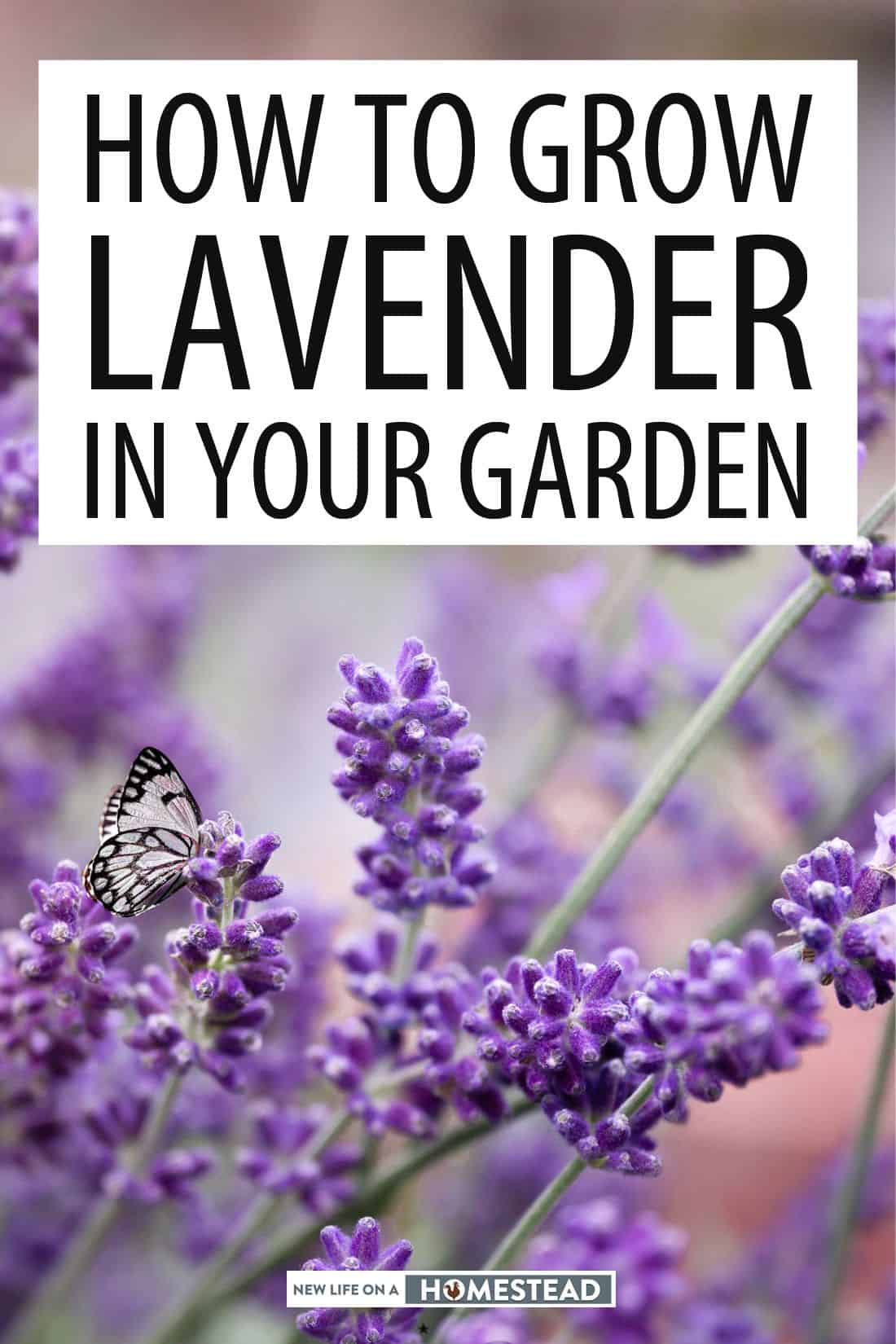Think of long lazy days in the South of France, and you will be in the lavender fields of Provence. Stretching as far as the eye can see, these blue purple blooms fill the air with their sweet fragrant scent. This eternal symbol of Provence grows with the dazzling Mediterranean Sea as its backdrop.
Fortunately, the South of France isn’t the only place that lavender will grow. Almost all of us can enjoy its beauty, fragrance, medicinal qualities, and color wherever we live. It does well in US Department of Agriculture (USDA) zones 5 to 9.

Providing it gets enough sunshine and drainage, lavender will do well. We’re going to look at where and how to plant and care for it. And we will consider the different varieties available. We will examine why it is a good plant for the homesteader.
Lavender is a bushy, easy to grow shrub plant, and if you are in a warmer region, you will find that it will keep its evergreen foliage all year. It has been known to repel insects, and relieve the symptoms of insect bites from as long ago as Roman times.
Why is Lavender Good to Grow?
All lavender varieties are excellent at attracting bees, butterflies and pollinating insects. They are good for repelling unwanted insects such as mosquitoes. Lavender is a great plant for companion planting, planting alongside shrubs and roses.
For centuries, lavender has been used in the kitchen. It is a member of the mint family, and can produce an unexpected flavor when added to sweet or savory dishes.
The flowers and the flower buds can be used in cooking. Look for recipes using lavender in ice cream, scones, biscuits and cakes. You can add some flower buds to a jar of sugar. This will give the sugar an added sweetness and is ideal for adding to desserts.
Fresh buds can be sprinkled on salads, used to infuse teas and cocktails and to flavor roast lamb, chicken or rabbit.
You can add lavender stems to your charcoals on the barbecue for flavoring. Similarly, French lavender is often used in the blend of Herbes de Provence to introduce a subtle flavor.
Lavender oil is commonly used in aromatherapy, and for soap and perfume products.
Lavender can be dried by collecting the bunches and tying a strong elastic band around the base of the stalks. They should be hung upside down until dry.
The quicker the stems are dried, the less color will be lost. Whilst drying, the plant should be kept in the dark and in a dry place with good ventilation.
Varieties of Lavender
There are over 30 species and a huge number of varieties of lavender to choose from. There are differences in color, scent, size and hardiness. In practice, there are only 3 species which are commonly grown.
English lavender (Lavandula Angustifolia and Lavendula Intermedia) is one of the most commonly grown varieties. It provides an abundant show of vibrant deep blue-purple colored flowers during the summer.
This species is usually hardy and can therefore be left outside even during the winter. It has a particularly strong lavender scent and silvery leaves.
English lavender is also available in different shades of mauve, pink and white. This is a tough plant which will grow up to 3 feet tall so it is also a great choice for the cut flower market. It is cold hardy to USDA zone 5 making it ideal for cooler climates.
French or Spanish lavender (Lavendula Stoechas) is easy to recognise as the flowers have a shaped flower head which is topped by petals which resemble rabbits’ ears.
This is the earliest of the lavenders to come into flower, and they will flower for a long time. They are less hardy and only really suitable for USDA zones 7 to 10. These varieties will not tolerate wet or frosty soil during the winter.
There are also the non-hardy lavenders (Lavendula Canariensis, Lavandula Dentata, Lavandula Lanata, Lavandula Pinnata) which are tender and can’t be left outside over the winter.
They can either be grown as annuals, or if grown in pots, brought into a greenhouse for the cold months. These tender plants are usually short-lived, and are best grown in containers or pots.
Providing your location is suitable, if you plant a mixture of both English and French lavenders you will have an extended flowering season which can last for up to ten weeks.
Where and How to Plant Lavender
Fortunately this beautiful, perennial plant is not fussy and lavender will succeed in even the harshest of garden conditions and in the poorest of soil types. In fact, lavender will prefer poor, dry soil or soil with only modest fertility.
Chalky, alkaline soil is best, and you should avoid planting it in heavy clay soils. Clay soil becomes waterlogged over the winter.
You can grow it successfully in the ground or in a pot or container. When choosing your planting site, there are plenty of options available to you as long as you just remember two things – sunshine and drainage.
Lavender does need plenty of sunshine and well drained soil, as do most plants with silvery-green foliage. It’s also important to plant any variety of lavender in a fairly wind-free spot.
If you have a garden path, plant rows of lavender along its length, and you will be able to appreciate the plant’s strong scent every time you approach your front door!
You can grow it as a low growing hedge or use it to create an edging to a border. Likewise, plant under or around a seating area and let the sweet fragrance waft up to greet you when you take a well-earned work break on a hot summer’s day.
You can also grow lavender in a border with other plants, perennial flowers or roses. When choosing plants to grow with lavender, look for plants with similar growing requirements. Some good examples are sedums, asters, and gypsophilia.
Alternatively, try growing it on its own, in a border dedicated to cut flowers. Lavender is a plant which is great for cutting because of its delightful perfume and longevity.
Another great and natural choice of site for lavender is in the herb garden which will ideally be situated close to the kitchen.
The best time to plant lavender is in the Spring, providing the ground is not waterlogged. The ground naturally becomes warmer during April or May, and there is likely to be a better choice of plants available to buy at this time.
You can plant later in the summer providing the plants are kept moist. However, you should avoid planting in the winter months due to the propensity of the plants to rot in cold, wet soil.
Once you have bought the plants, you should plant them out as soon as possible. Tease them out of their pots carefully. Don’t just pull them out by grabbing the foliage as this can cause damage to the main root.
Once the plant has been released from the pot, if you scratch along the sides, you will make tears in the small roots that were at the edge of the pot.
For each of these roots you tear, another two or three roots will grow, so don’t be afraid that you are damaging the plant. You don’t want to damage the main roots, but by scratching away at the thin side roots, you will be helping the plant to develop a strong root system.
Allow about 3 feet between the plants if you are planting in groups. If you are planting a hedge then the plants should be spaced about 1 foot apart. If you have no option but to plant in heavy soil, you can plant them at the top of a mound so they will be raised up from the ground level.
Once planted, water the lavender plants copiously. They need to be watered regularly during the first growing season. Adding mulch after watering is a good idea as this will help to stop the pots from drying out.
Container growing is possible too. Just remember that lavender plants can grow to the size of small shrubs. So the pots you choose should be no smaller than 12 inch in diameter, and you can select an even larger size. This will give your lavender plants room to grow.
If using pots, you need good drainage, so put a layer of crocks or gravel in the base, and make sure the bottom has good sized drainage holes.
Use a sandy potting compost and mix in some coarse grit or perlite, as this will also improve drainage. Finally, add a tablespoon of lime. This will raise the alkalinity level of the compost.

Growing Lavender Indoors
Some people want to know if they can grow lavender indoors; to grow it successfully inside does present some challenges, but on a small scale it is certainly possible.
You will have to give the plant the right light and care and it is a good idea to choose a smaller variety. Even a smaller plant will probably not fit onto your window sill so you will need to set up a small table or plant stand by a bright, south-facing window.
Ideally, it needs a minimum of three hours of direct sunlight, so place it where it will receive as much light as possible.
If your plant is not getting sufficient light, it will produce weak growth, look straggly, stop flowering and be susceptible to disease.
Good air circulation is important but the plant should not be exposed to currents of hot, blown air. Try to keep the indoor temperature from spring to fall at around 50 to 55 degrees Fahrenheit (10 C to 12 C) at night, and around 70 degrees F (21 C) during the daylight hours.
During the winter, the plant will benefit from cooler temperatures: 45 degrees F (7 C) at night, and around 60 degrees F (15 C)during the day.
Once the danger of frost has passed, you could consider moving the plant outside. Water it regularly as it will dry out more often. Once the plant has had a few weeks to get accustomed to being outdoors, you could plant it in a sunny spot.
When watering and indoor plant, water it well and then allow the soil to almost dry out before watering again. It will automatically seek out light so turn it round weekly. This will ensure you get uniformity in growth and flowering.

Lavender grown in pots indoors will need a monthly feed during the summer. Use an organic, all-purpose soluble fertilizer, and make it up at half the directed strength.
After a year, you will have to re-pot the plant, using a good quality potting compost. Use an 8 inch pot, and re-pot during the spring or early summer.
Aftercare
Lavender grown outside generally will not require any fertilizer because, as already mentioned, it prefers nutrient-poor soil.
After the first season, lavender planted in soil becomes a drought tolerant plant. Unless there is a prolonged hot and dry spell, it will rarely need to be watered.
However, container grown plants will require regular watering during the summer. Their roots have little soil from which to draw up moisture and they will dry out quickly.
Before you buy your plants, make sure you check the label for hardiness if you wish to leave the plants outside during the winter.
Even if you have opted for a hardy variety, such as English lavender, if you are growing in pots, you will need to move them to a sheltered spot for the winter.
This is because the roots are less insulated than if they were planted directly in the soil. The cold will attack the plants from all directions.
In the winter, move the containers to a greenhouse or cold frame where they should be kept fairly dry.
Another good place to overwinter lavender, is at the base of a wall where the pots will be protected from excessive rain. They will receive some shelter from the cold and wind.
Of course, if you are growing them in pots, it is easier to maintain them in a sunny position because you can move them around. And if you are growing a less hardy variety, you can provide shelter from the cold winds and frost.
Lavender can become straggly with unsightly woody stems. To prevent this and to ensure your plants remain attractive, you need to prune them once a year. Trimming your plants also helps to prevent them shading any shorter plants you may have growing behind them.
The best time to prune the plants is just after they have finished flowering. In late summer, remove any dead flower stalks as well as about 1 inch of the leaf growth from the plants.
In the spring, if any of the growth has turned brown or got damaged by frost you can clip the foliage. But don’t cut back into the woody stalks because lavender will not normally create new growth from the old stems.
Even with the best of care and annual pruning, old lavender plants will become woody and mis-shapen. This is because they grow quickly. So if you wish to keep your lavender looking tidy and healthy, you will need to replace the plants after 5 years or so.
Propagating
Make more lavender either to add to your plants or to replace old plants that have become unattractive and straggly. It’s easy to do this in the spring or early summer.
Simply make some cuttings using the soft growth from the plant. Take some of the soft shoot tips, and they will root easily. Just pop the shoot tips in some cuttings compost and place inside a closed propagator in good but not scorching sunlight.
It’ll take about 4 weeks to get a good root system grown on the cutting by which time you can pot it up and lead it to grow on.
If you decide to collect the seeds from the dry seed heads in the late summer, store them over the winter. Sow these seeds in the spring in small pots or seed trays filled with seed compost.
Propagating from cuttings will produce plants identical to the parent plant, whereas plants raised from seed will produce plants that will vary from the parent. Almost all commercial lavender growers propagate their plants from cuttings, rather than seeds.
Disease
The overwhelming majority of problems experienced with growing lavender have to do with growing conditions, rather than pest or disease.
However, there are some potential diseases that can affect your lavender. Many people claim that lavender is immune to disease. It’s true that lavender is known more for its healing properties than for disease.
Nevertheless, there are a couple of diseases that can attack the plants, so it is worth being aware of them so you can keep a look out for problems.
Phomopsis lavandulae is a fungus that attacks and kills the stems of the lavender plants. The first symptom you will see is the shoots wilting as though they have not been watered even though they have and the plants are moist.
The main problem with it is that it potentially can kill many thousands of plants at once, because the spores of the fungus can travel with the wind along the length of rows.
This can be catastrophic for a commercial lavender grower who may have no alternative but to destroy huge numbers of plants. If you do have affected plants, you should try to burn all the infected material.
Mosaic virus is another disease which is easy to spot and will cause lavender leaves to turn yellow and then curl up.
Because this disease can be caused and spread by insects, it is important to catch it as early as you can. Dig out the infected plants and burn them if possible.
Please, don’t panic! The above two diseases are, thankfully, extremely uncommon. You will probably never encounter either Mosaic Virus, or Phomopsis Lavandula.
But there is a far greater threat to your lavender plants in the form of what is known as Wet Feet. This is a rot and is caused by allowing the plant to stand in soil which is too damp and chilly around its roots. It is especially a risk over the winter.
Once this rot has set in, the woody stems will begin to die. Although it may take a little while for the plant to appear as if it has completely died off, it is already dead and needs to be destroyed as soon as possible.
You can minimize the chances of experiencing fungal disease and rot by providing as much sunshine as possible. Avoiding wet or heavy soil and maintaining good drainage is the number one tip. Secondly, never overwater during the winter and this will also help to avoid such problems.
Finally, remember that as previously discussed, not all varieties of lavender are hardy, and the less hardy plants will die off if temperatures plummet beyond their zone tolerance.
Pests
There aren’t many pests that will pose problems, and any that do feed on the plant will only cause superficial damage. There is no need to use any pesticide as no serious damage will be caused.
These pests include cuckoo spit, rosemary beetle and the sage leafhopper. Rabbits and rodents won’t cause a problem either. The oil in the lavender leaves causes the scent and this repels pests – including mosquitoes, flies and other unwanted insects.
Making Money from Lavender
You can make money growing lavender in several ways. If you are growing on a small scale, an easy and profitable way to monetize your lavender is to make and sell fresh lavender bouquets.
Lavender bunches sell at between $6 and $10 at local markets. A 10’ x 20’ area planted with lavender will produce around 100 to 150 bunches per year.
Any unsold bunches can be dried by hanging upside down and sold for floral displays or to crafters. With more effort, lavender products such as pillows, sachets, and soaps can be produced and sold. Adding value by producing products such as these can increase your potential return by up to 500%.
The demand for lavender and lavender products continues to increase, so there is ample opportunity to cash in on the growth of this business.
Even if you don’t want to make a profit from lavender, you can still benefit from its addition to your garden in a multitude of ways. Have fun!


Sally is a retired English lawyer who spent 20 years homesteading on the Welsh hillsides in the U.K.
Semi-retired, she moved to France 15 years ago, where she and her husband set about restoring a 14th century watermill which came with 5 hectares of woodland, riverbank, and pastureland.
Using the skills and experience gained in the U.K, they continue to enjoy working on their land, woods and water.
